has summarized for us the important
facts that has lead to where we are today.
The story began in 1892 with the
discovery of high grade ores, rich in silver and lead. The results were
the making of small towns and smelters throughout the Kootenays when
traveling between towns was very rugged.
1896
A gentleman by the name of William
Ridpath. a spokane lawyer invested heavily in several Kootenay mining
ventures and was among one of the first backers of the fabulous LeRoi Mine
at Rossland. Ridpath was said to have renamed a huddle of tents at Mark
Creek Crossing because he hoped the camp would have the same luck as the
South African centre "Kimberley." Ridpath was to have said to have paid
$24,000 for the Sullivan. There was also a tale of a Mr McArthur who
grubstaked with Mr. Pat Sullivan who apparently was said to have died
three years earlier. Being one of the four men who discovered the Sullivan
Mine he stated that he woke up and counted a dozen tents back in 1892.
They had made an important discovery then and there was where he picked up
a piece of a wooden box and wrote "Kimberley Camp" on it and nailed in on
a tree beside the fire.
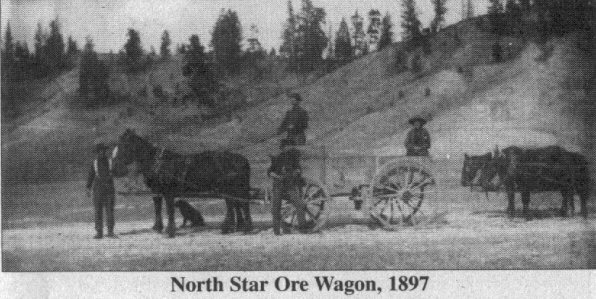
1898-1899
The original townsite of Kimberley
was surveyed by Thomas T and A.S. McVittie of Fort Steele and subdivided
into lots. The boundary of Townsite at this time was Leadenhall (South),
to Jennings Ave (East) to North Star (west).
The St.Mary’s Wagon road to Matthew
creek was put in.
The North Star Hotel was built and
the owner was Harry Drew. Drew owned the hotel from 1898 to 1910, and was
quite a character. People said he was the most colorful man to move into
the area at the time. In his hotel the saloon section never closed its
doors and it ran 24 hours a day with three shifts of barkeeps. Harry
Webster Drew studied law and self defense back in Boston where he grew up.
He worked out as a sparring partner for such men as James J Jeifries who
became the world’s heavyweight champion and Tom Sharkley. When he had to
handle roughnecks, a class that seemed to patronize saloons in that era
his fists could tell a story. At the saloon you could play slot machines,
both mills big six and the dime jackpot type, plus poker, blackjack and
dice games ran full blast. Harry Drew stood 6 foot tall and weighed about
190 lbs. wore a large mustache, drove a Cadillac and was well respected.
Legend has it that when he moved from Boston he was friends with a Mr.
Stoper who owned a hotel in High River. Alberta. They moved the hotel from
High River to Cranbrook when the railway came through and rebuilt on Baker
Street in Cranbrook to be known as "The Manitoba." In the meantime with
the discovery of the Northstar and the Sullivan properties Drew and Stoper
moved to Kimberley and built the Northstar Hotel. Harry Drew lived a life
of riley until prohibition came in. Leaving him with a stake to the value
of $5000.00 and his doors closed to the public. This broke his heart. Drew
then moved to the coast where in a few short years he died of just that.
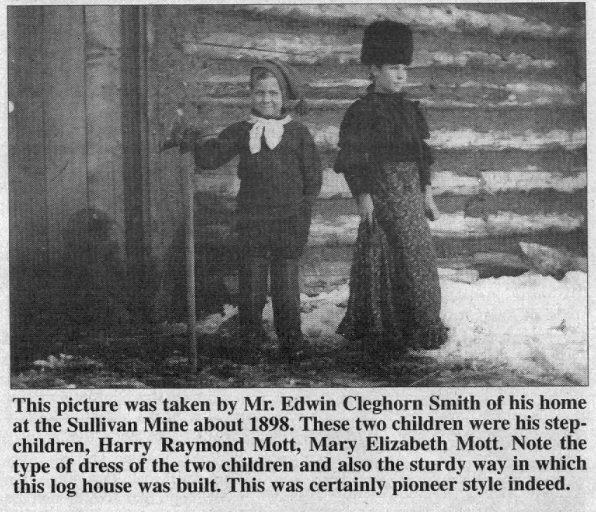
Hotels built around this time were
The Spokane which went up in smoke as did the Forsythe Hotel, The Jones
and Finch went for a ride to Marysville and back to be known as the Falls
View. The Ontario hotel was built by Jim Carroll and went for taxes in
1914 as did The Kimberley as well.
The townsite of Marysville was
staked out in 1894 by Bill Meacham who was one of the first trapper
prospectors to settle around Mark Creek. Until 1903 the total settlement
in the new townsite consisted of three or four shacks. The smelter was
built for the treatment of ore being mined at the Sullivan and North Star,
a short distance north. With the start of the smelter, Marysville was
booming. Stores were built and the "Marysville News" started and hotels
were constructed.
1900 to 1910
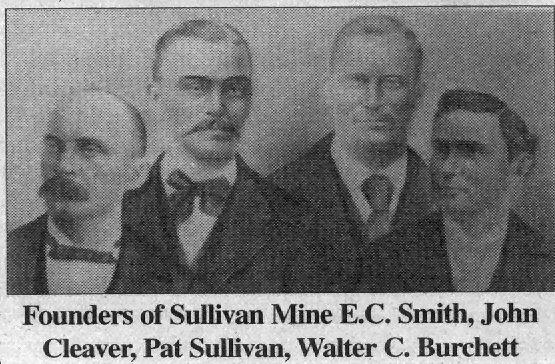
Prospectors Ed Smith, John Cleaver,
Pat Sullivan and Walter Burchett who are now peacefully resting at the St.
Mary’s Mission, were gathering supplies after a very rugged overland trip
from Kootenay Lake and decided to stop and see the finds at the North
Star. They couldn’t - believe what lay betore them - rich ore lay in cuts
on the surtace. With great enthusiasm and excitement the men then set out
to explore the slope on the other side of the creek. Pat and Ed went along
the creek while Walter picked up a piece of "float" and to his amazement
noticed a great rust stain "ORE?’ And this was the discovery that built
Kimberley into a town. Unfortunately only in Walter Burchett’s later years
did he learn the tremendous extent of the discovery. The others died
without really knowing their find was to become "the big one."
The first log cabin school was built
in 1900 where the Elks hall is today and the second built at the North
Star mine and in 1904. The third school in Kimberley was built and was a
small white structure where the Cominco General office is today. A tramway
was eventually built at the Sullivan to carry the ore from the Top Mine 1
1/2 miles down the mountain side to the creek bottom.
From 1900 to
1910
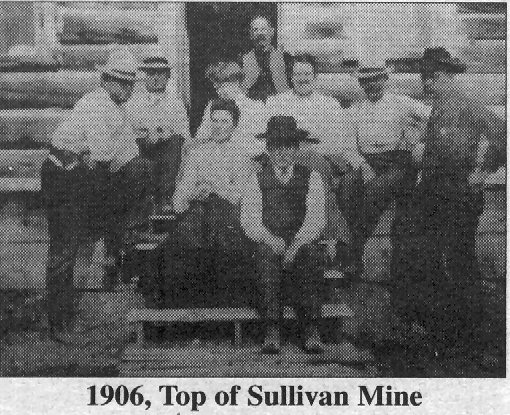
Kimberley became a small mining town
and for the most part the activity was high on the top of Sullivan Hill
and across Mark Creek at the North Star. An aerial tramway was built to
carry the ore on the North Star, earlier on the ore was raw-hided down the
mountain by horses. There were no fancy buildings at this time as that was
a huge expense in those days.
Some said that Moyie and St. Eugene
were very rich and the gold found in the Wildhorse and Perry Creek had
great tales to tell. The greatest talk at this time was the find at the
North Star. This was the jewel that brought the many prospectors and
miners to a small valley that was to be known as "Mark Creek Crossing."
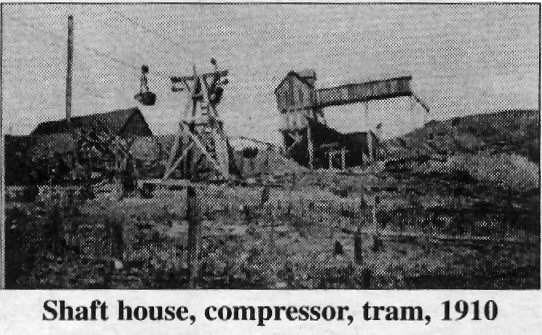
A branch of the CPR rail line was
brought to Kimberley from Cranbrook over the St. Mary’s River near the
mouth of Perry Creek. With the railway moving in, The McGinty trail that
ran down the North Star and through the middle of town was terminated. At
the time The Sullivan Mine employed only 35 men.
Hotels - The Marysville Hotel
(1900-1903) was lost to fire and not rebuilt at this time. The central
hotel (1903) later owned by the Bird Brothers which was used as a hall and
Centre for village activity. The Royal Hotel (1904) burned in 1908 and was
rebuilt and then burned once again. The Falls View Hotel (1900’s-1906)
first was in Kimberley then moved to Marysville and then back to Kimberley
became a furniture store in the location of Howard Street. Saloon’s never
closed, they were wide open barring slot machines, poker tables and at the
time the smallest coins were nickels and strange enough at the time it was
illegal to sit down.
By 1901, Kimberley housed 41 people
and hotels, the post office and buildings were being constructed. Down in
Marysville the excitement of the start of a mining smelter was in the
works. The Sullivan Mine workings were just below the surface and they
were so irregular as to defy any written descriptions. While at The North
Star it was getting thin and clean up had begun.
In 1905 the North Star was almost
abandoned and the Stemwinder came into the picture. With the ore at the
Sullivan, low grade iron and some zinc the total tonnage was thought to be
around 25,000 tons of reserves. There didn’t seem to be a future!
The ore was weak and hard to handle at the Smelter in Marysville and the
chances of it being a big producer was very small.
Between 1906 and 1907 Charlie
Gaskill logged The Stemwinder and only took the cream of the crop. Earlier
he logged the North Star. In 1909 the Taylor Lumber Company who saw some
valuable timber left, moved in. They logged Blarchmont Park, adjacent to
Morrison Sub as far south as Chapman Camp and Cherry Creek. They employed
about 40 men at the time. There was more activity at the Taylor’s Mill
because the Sullivan Mine was shut down in 1908. Prices were good. The
mill was where the old trestles were at the now city works yard.
In 1907 the smelter shut down and
was closed by 1908.
In 1909 the consolidated (CM&S
Company) took option on the Sullivan mine property, no ore was shipped and
the North Star and Sullivan Mine were shut down. Prices for lead and
silver were low. Time had stopped.
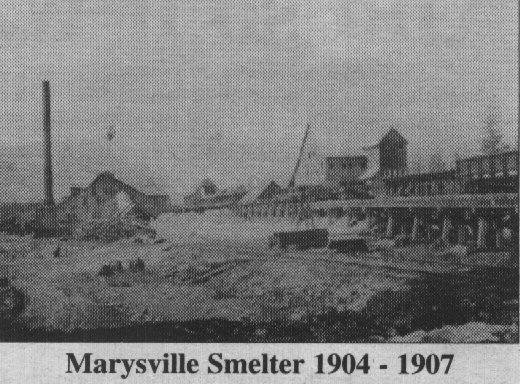
In 1910 there was no ore shipped and
the CM&S Company purchased The Sullivan Mine for $200,000 dollars.
As we watch The City of Kimberley
grow in the year 2000
certain areas around the mining town have historical
values. Around the turn of the century (1900-1925) the town started to
unfold.
Wallinger Avenue
Wallinger Avenue was named after Mr.
N.A. Wallinger, gold commissioner, Government Agent and MLA of Cranbrook.
In 1915, times were tough in the East Kootenays and employment was
slim with many worked for board alone. Wallinger said, "No one is going to
go hungry as long as he was a government agent." He even wrote out cheques
for citizens to cover groceries. Wallinger Avenue which runs from the now
Centennial Hall to the top of Blarchmont hill was just an old rutted road
and not used very much. At the time there was only one building as it came
to an abrupt end at Spokane St. From there to the creek was nothing but
swamp and when the avenue was extended into upper Blarchmont in 1922 it
was nothing but mud and water.
In 1909 the Taylor Lumber Company
logged the upper Blarchmont area.
A few interesting tidbits of
historical value:
-
the first church in Kimberley was
the Methodist church which burned in 1911.
-
the first settler was rancher
Robert Jennings
-
the first street was Spokane
Street
-
the first store was Mr. & Mr.’s
Estmere’s (Mark Creek Mall)
-
the first picture show was at
Handley’s Hall
-
the first post office was beside
the Black Forest Haus of Gifts on Spokane St. (1903)
-
the first hospital was opposite
The Company General office
-
another hospital was at the tunnel
on 3900 level/bunkhouse (1917)
-
the first Bank was "Bank of
Montreal" (1919)
-
the first car was owned by Mr.
Handley a Model T Ford
-
the second car was owned by Harry
Drew, a cadillac the proprietor of North Star Hote
-
the third car was owned by Alex
Taylor a ford
-
the first real ice surface was at
the top of the mine tennis court(1917)
In 1911 the Mark Creek dam was built
and the 1st of July celebrations were started on Spokane Street.
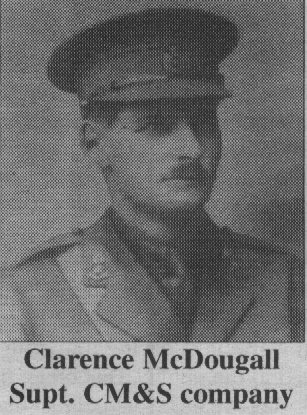 The
Handley’s old home was at the rear of The Canadian Hotel and was thought
to be Kimberley’s oldest building. The Handley’s lived there at the turn
of the century and had two teams
hauling ore from The North Star.
The
Handley’s old home was at the rear of The Canadian Hotel and was thought
to be Kimberley’s oldest building. The Handley’s lived there at the turn
of the century and had two teams
hauling ore from The North Star.
July 1913 the festivities started in
Kimberley with various events being held for the community with prizes of
$3.00 for 1st, $2.00 for 2nd and $1.00 for 3rd. Events such as standing
long jump, running long jump and married ladies race, singles, egg and
spoon races, sack races, shoveling, chopping, sawing, ball games, dances,
and the fat man’s race.
By
1912 Tommy Evans
doused the coal-oil lamps and brought Kimberley its first spark of
electricity.
In 1912 the
Marysville bridge was
the only crossing over Mark Creek with the exception of
the bridge to the North Star Mine and the road for Black Bear to
Marysville was opened and in later years ski jumping was big at
Blarchmont.
Meadowbrook was named in 1914
The name Meadowbrook came from a
Mrs. Clarence Connover who named the Connover homestead "Meadowbrook
Ranch" the name applies to the whole area now. It was logged off by the
Otis Staples Lumber Company of Wycliffe in 1906, 1907 by camp #4.
The first settlers in the area were
the Connovers, Flemings, Houles, John Louis and Paul, with Douglass, Carl
Quick and Jack Dobson. Most houses were log at the time and the first
school was built and the teachers name was Miss I.S. MacKenzie.
Mr. Eimer a recent arrival in 1914
took over 160 acres with a lake on the bench. His homestead was back
towards the hill on the present site of Higgins Street. It was known as
"Frenchtown" because of all the french people living there. There was
protection there from strong winds and the crops were abundant.
In 1916 the first flood of
Mark Creek occurred flooding most of the downtown area.
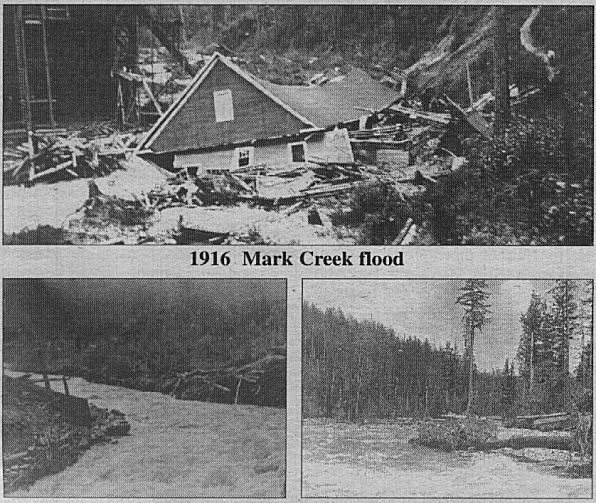
On Marsden avenue Ed London owned a
ranch with 2 1/2 to 3 acres of fertile land. When the creek changed
course in 1916, Londons land was sold to the North Star. Cominco fenced it
in around 1922 and used it as a hog pen for about 45 to 50 hogs at a time.
The pork was used in the meals for the construction men in camp.
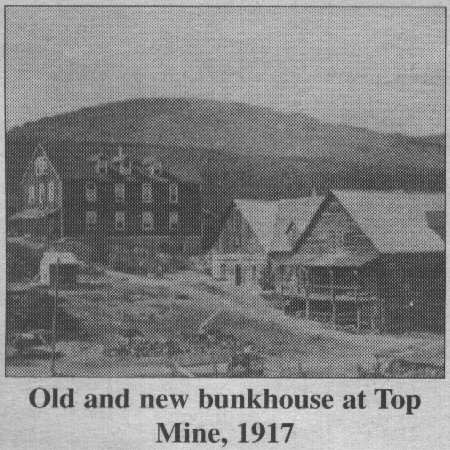
In 1917 there were four or five
stores in Kimberley proper and a bunkhouse and cookhouse were built by the
3900 level of the Sullivan Mine and was used as a temporary hospital
during the Spanish flu epidemic which was disastrous. The flu killed 25 to
30 million people throughout the world. It was the most deadly epidemic of
the 20th century. Even the Stanley Cup finals were cancelled. Joe Hall of
The Montreal
Canadians died of the deadly flu. More than 3,000 people in BC also died.
By
1918 400
people were residing in Kimberley and the metallurgy of the Sullivan Mine
ore was being solved. The superintendent of The Sullivan at the time was
EG Montgomery.
Harry Gamble was the underground
manager at The Sullivan Mine and his daughter Lois died of the flu
epidemic. The Lois Creek Lake and subdivision were named after her.
1919 brought a serious forest
fire which was in full force on Sullivan Hill and the north Star. A train
was sent to Cranbrook and the town was evacuated. This was not a good year
for Kimberley, the forest tire, the flu and The Sullivan Mine was on
strike.
The OBU was formed in 1919 (one big
union) and the "The Bank of Montreal"
was the first bank to open.
The 1st ordained minister in
Kimberley was Rev. Stanley Redman and the first Sunday school started in
1919.
The hospital was in the present home
of Mr. C. Crisford operated by Dr. Hanningtion opposite the Company
General office.
Spokane Street
Was the heart of the business
section of Kimberley and still is to this day. Spokane Street was the main
road used by the North Star Mine using horses and wagons via The McGinty
road built in 1895. The only buildings on Spokane St. south were
the North Star Hotel, The Mark Creek Store, The Forteith Cafe and the
lock-up near the McGinty road. An old sidewalk went down the North Star
Hotel now the Golden Inn Chinese restaurant with the Miners hail at the
end.
1920
Down in Kimberley proper the new
Mark Creek store opened. The name Blarchmont was introduced after
Blaylock, Archibald and Montgomery. A curling
rink was built in
Townsite where the vacant lot is across from the townsite grocery and a
public school was built across from the St. Andrew’s Presbyterian church.
By 1920, the Cominco chemists had
solved the Sullivan ore problem.
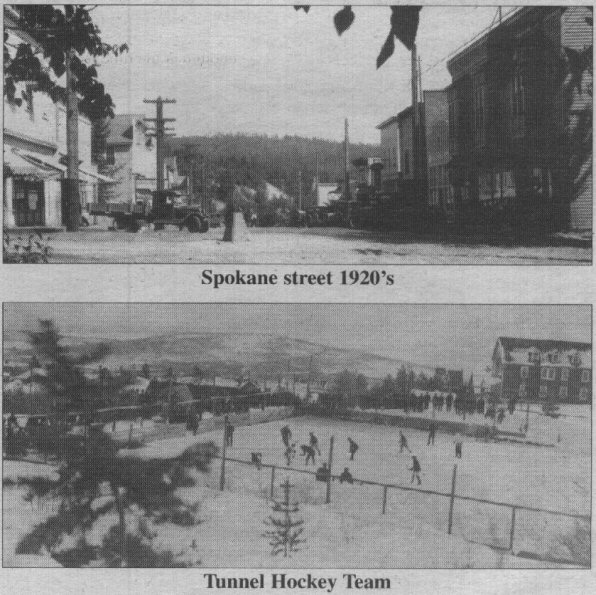
Organized hockey
was
formed with seven man teams who played the
entire game with 60 minutes of playing time and leagues had begun with
rivalries from Wycliffe, Cranbrook and Lumberton.
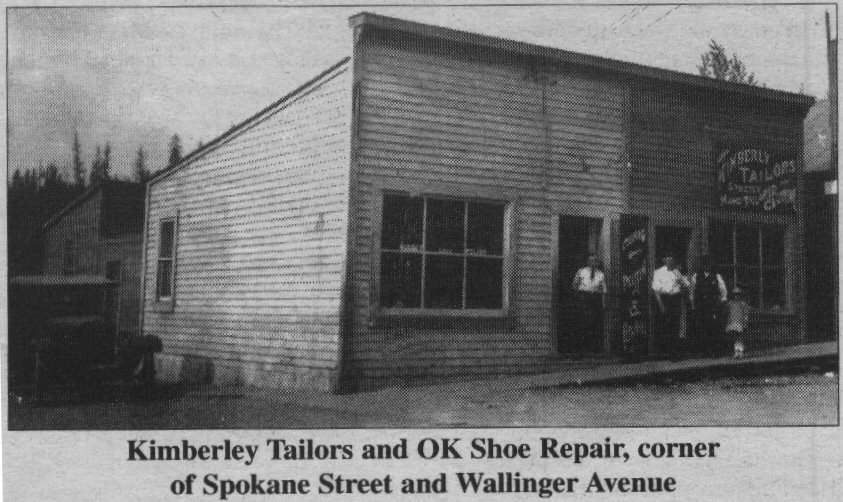
Up on McDougall 2nd and 3rd avenues
were cleared and homes were started to be built.
1921
Blarchmont up until 1921 was a
logged off area when construction for homes began.
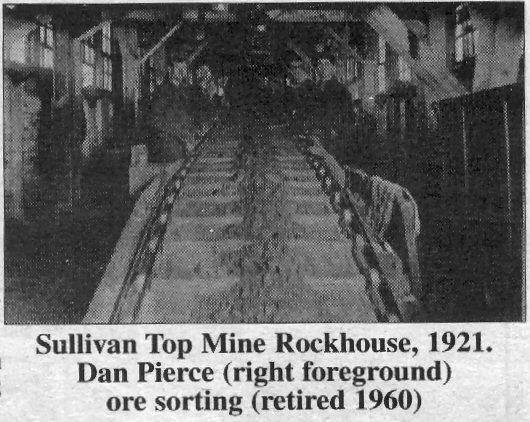
It was told that the first person to
grow up in Kimberley was Nel Tofett. The first power line was strung to
McDougall Townsite & wiring commenced. East Kootenay Power turned on
November 5,
1922 with 18 customers.
In 1922 the 1st Catholic church was
built at the corner of Wallinger and Howard street, the now site of the
Kimberley hotel parking lot, it was destroyed by fire. This was succeeded
by the Presbyterian church on the same site. The present Catholic church
was built in 1927-28.
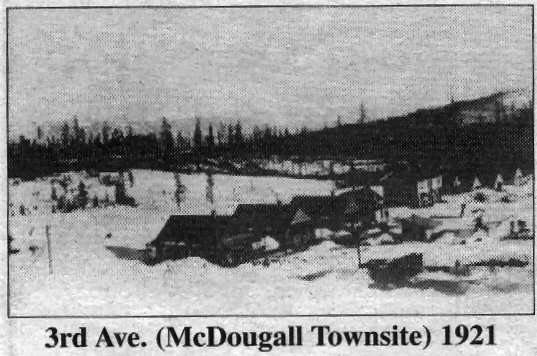
Chapman Camp was named when
construction started in 1922 on the concentrator and began when Bill
Lindsay sent ED Houle and his gang started to clear the site. Paul Louis
was the blaster, A.A. Watkins and A. Spinks, Jack Dobson, George Frieake,
Ira Foster, Jack Kavanagh, Gus Soderholm. John Pighan and Wilfred Houle
formed the group.. In 1922, F. Chapman was superintendent at the mine at
the time. A cow-trail was put in from the concentrator to Taylor’s Mill. A
cookhouse and dining room were run with Sid Johnston and Mark Beduz as
cooks accompanied by 10 assistants. 450 men were then hired, 56 bunkhouses
accommodating 5 men each, and a rampasture was built to make room for 100
more men. A hall was built, to house the McKay’s Commanders orchestra with
Albert Hild on the violin, Vic Hild on the banjo, Marg McKay on the piano,
Doug Dunlop on the sax, Fred Webber on the trombone and Jack Evans on
Percussion.
Tommy Ellison was the postmaster at
the time.
The field at Chapman camp
was built and the
trestle at Taylor’s Mill was constructed.
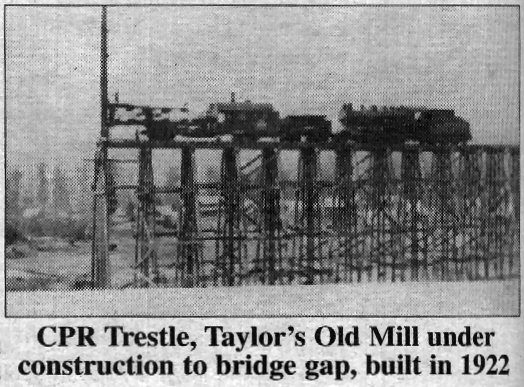
In 1923 six homes were built
on 2nd avenue at town-site and the Kimberley Hospital was built. Lights
and power became a reality in Kimberley & Blarchmont.
The government liquor store opened
with a vendor by the name of Mr. Gougeon who passed away in 1928 and
Grennie Musser took his place.
The Sullivan concentrator was
completed in 1923 and this was the big break for Kimberley and the entire
east Kootenay.
Baseball was at the village green
and in 1924 football was introduced in Kimberley.
Around 1924 there was the
beginning of a football league in Chapman camp and The Orpheum theatre was
built on Spokane Street at the old Reddy’ s furniture store.
Shacks and tents sprung up all over.
The company built six houses in 1923 on 2nd avenue. The camp was surveyed
and built into avenues and streets. Mel O’Brien who was assistant
superintendent built an outdoor rink at the right of the tracks going up
the concentrator hill. The first shacks were occupied by Joe Harris
(master pipefitter for the water works in camp), Mark Brooks, Dunc
Robertson, Nick McKenzie, Harold Andrews and Ross Doran.
Sis Young was the first girl born
there and Dunc Robertson Jr. was the first boy. The first baby to live in
camp was Mrs. Ross Doran. Early settlers in 1922-23 were Laughie McKay,
Howard Douglas, LE Herchenier, Jack Hargreaves, Joe Thompson, Tom
Crossley, Bill Angrove and George James.
At the time Oughtred hall
(1925-1952) had badminton, basketball, bowling, billiards meeting
rooms and confectionery. There was a curling rink, ball diamond, football
field, skating rink, swimming pool and ski jump.
The school was built in Chapman camp
and a new bridge over Mark creek at Wallinger, the Elks lodge began as
well as the opening of the Kimberley Golf club with N.W. Burdett as
president.
At the time a lot in Chapman camp
was $1.00 each ( 95’ x 75’)
New homes were being built in
Townsite with boulevards and trees.
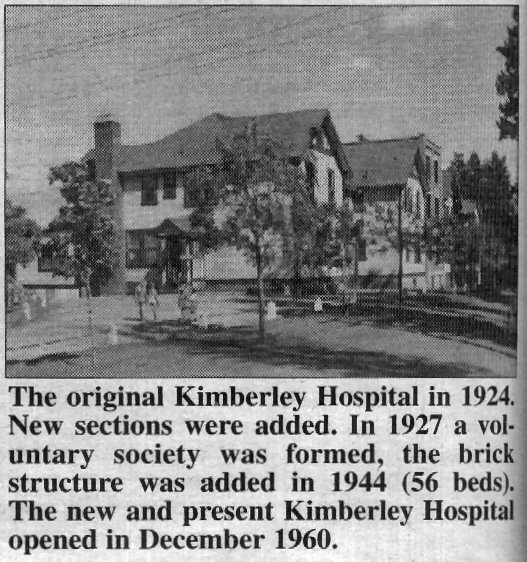
Rotary Drive was a long and desolate
road, no lights or bushes on either side. The only piece of the old road
is between the city works yard and the sully hotel, it crossed the tracks
at the city works. The Lois Creek was flumed down and emptied into the
Taylor’s Mill pond.
I have
scanned in the rest of this publication in images for you to read here
